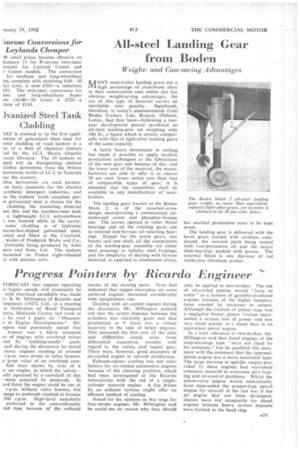Progress Pointers by Ricardo Engineer
Page 35

If you've noticed an error in this article please click here to report it so we can fix it.
FORECAST that engines operating tr higher speeds will eventually be with overhead camshafts was made Er. B. W. Millington of Ricardo and Engineers (1927), Ltd., at a meeting le Institution of Road Transport leers, Midlands Centre, last week at
he read a paper on " Measures in Engine Developments." Mr. ngton had previously stated that bounce was a fairly common re of engines with overhead valves ited by " knitting-needle " pushand during the discussion he stated many engines running at around r.p.m. were prone to valve bounce. e great value of an overhead camhad been shown by tests of a tr car engine, in which the valves— ally operated by a camshaft of this —were actuated by pushrods. In aid form the engine could be run at r.p.m. without valve bounce, but lange to pushrods resulted in bounce 500 r.p.m. High-level camshafts preferred to the conventionally ted type because of the reduced inertia of the moving parts. Tests had indicated that tappet clearances on some pushrod engines increased considerably with temperature rise.
Dealing with air-cooled engines during the discussion, Mr. Millington pointed Out that the centre distance between the cylinders was relatively great and that production in V form was a virtual necessity in the case of larger engines. This increased the first cost of the unit, and difficulties could arise from differential expansion, notably with regard to the valves and tappet gear. There were, however, good examples of air-cooled engine in current production.
Exhaust-ejector cooling was not satisfactory for air-cooled automotive engines because of the silencing problem, which had been investigated at the Ricardo laboratories with the aid of a singlecylinder research engine. A fan driven by an exhaust turbine might offer an efficient method of cooling.
Asked for his opinion on fire rings for four-stroke engines, Mr. Millington said he could see no reason why they should
only be applied to two-strokes. The use of oil-cooled pistons would "have to come" as a feature of quantity-produced engines because of the higher temperatures created by increases in output. Although the friction of piston rings was a negligible factor, piston friction represented a serious loss of power and was very much greater in a diesel than in an equivalent petrol engine.
In a later reference to two-strokes, Mr. Millington said that diesel engines of the loop-scavenge type "were not liked by his company," but he qualified this statement with the comment that the opposedpiston engine was a more successful type. The large increase in specific output provided by these engines had warranted extensive research to overcome port fouling and oil-control problems. Whilst the sleeve-valve engine would undoubtedly have superseded the poppet-type petrol engine for aircraft in the last war if the jet engine had not been developed, sleeves were not acceptable for diesel engines because heavy carbon deposits were formed in the head ring.












































































































